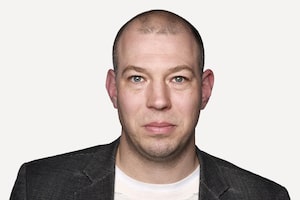Suspect No. 2, Dzhokhar Tsarnaev, is shown in the upper centre of the frame, wearing a white baseball cap, walking away from the explosions.David Green/The Associated Press
The high-stakes decision to release photographs of the suspects in the Boston Marathon bombings helped investigators smoke out brothers Tamerlan and Dzhokhar Tsarnaev. But it also "may have led" to the murder of a college campus police officer, Boston Police Commissioner Edward Davis said Sunday.
As investigators anxiously waited to interrogate the only surviving Tsarnaev brother, Dzhokhar – who is unable to speak because of a bullet wound to his neck – senior law enforcement officials offered the public an inside view of the backroom debates that led to the investigation's riskiest tactic: using crowd sourcing to identify the two men who police believed were behind the bombings .
It was a discussion that reached the offices of United States Attorney General Eric Holder and FBI director Robert Mueller, the New York Times reported. And the decision to release the photographs was the right call, Mr. Davis told the Boston Globe.
"It forced them out of their hideout," he said. The release on Thursday afternoon of video and still images of the brothers likely contributed to the pair's alleged violent rampage several hours later – a rampage that included the murder of a Massachusetts Institute of Technology police officer , the armed carjacking and a wild shootout with police. But the pair were intent on harming people, he said, whether it was Thursday night or some later date. He said: "It's my belief that they were already manufacturing explosive devices. Further violent acts were inevitable."
Initially, it didn't look like police would need the help of the public to identify the culprits. The New York Times reported that, in the days following Monday's bombings, the authorities were deluged with thousands of tips – but none leading to the Tsarnaev brothers. "We thought we had good leads," one senior law enforcement official told the Times. "We were working on some stuff and we got to the point where it levelled off, and then there was nothing imminent, so we moved with what we thought would result in identifying them."
Exactly why the brothers allegedly arrived at the MIT campus Thursday night armed with guns, at least five homemade grenades and another pressure-cooker bomb, remains a mystery. Only about five hours after their images were released, the brothers walked up to a parked police cruiser at MIT where one of them allegedly shot and killed the officer, Sean Collier.
It was the brothers' next move – car-jacking an SUV – that led the authorities to them, according to Watertown police chief Ed Deveau. The driver of the vehicle was allowed to leave unharmed, but left behind a cellphone. Police "pinged" the phone to determine that it was in Watertown and soon enough a patrol officer spotted the pair, Mr. Deveau told the Boston Globe on Sunday.
After being spotted, police said, the brothers traded gunfire with several officers – Mr. Deveau estimated between 200 and 300 bullets were fired – before Tamerlan, 26, walked toward the officers, firing his weapon until he ran out of ammunition. As the officers grappled with him, Dzhokhar sped toward them in the SUV, colliding not with the police, but with his older brother – an impact that may have been the blow that killed the elder Tsarnaev, Mr. Deveau said.
So far, Dzhokhar, 19, has not been able to explain anything. He has been in Beth Israel Deaconess Hospital in Boston since his capture Friday night. Citing unnamed law enforcement sources, some U.S. media reported he is being treated for a leg wound and a bullet wound at the back of his neck. The location of that wound has prompted speculation he may have tried to kill himself before he was apprehended.
ABC and NBC news networks reported late on Sunday that Dzhokhar was awake and responding in writing to questions put to him by authorities after two days under sedation in Boston's Beth Israel Deaconess Medical Center.
Other U.S. news sources, including CNN, said he was still sedated in the intensive care unit with a breathing tube down his throat.
One of his college classmates told Reuters Sunday that he saw Dzhokhar at the gym Tuesday night, less than 30 hours after the bombings. He was listening to his iPod, working out, said Zach Bettencourt, who went to school with Dzhokhar at University of Massachusetts-Dartmouth.
The subject of the attacks came up. According to Mr. Bettencourt, Dzhokhar said: "It's crazy this is happening now... These tragedies happen all the time in Afghanistan and Iraq."
With a report from Reuters
 Greg McArthur
Greg McArthur